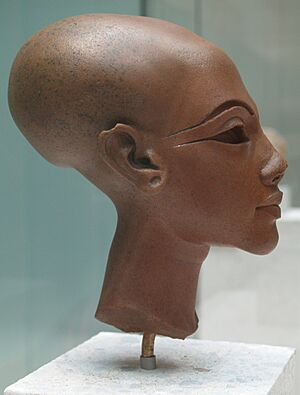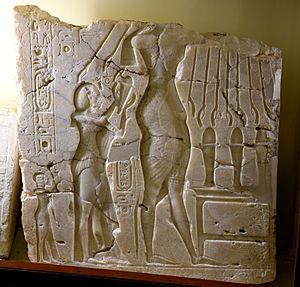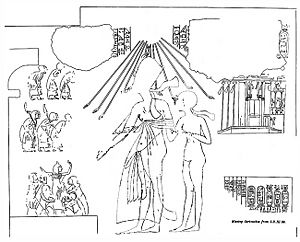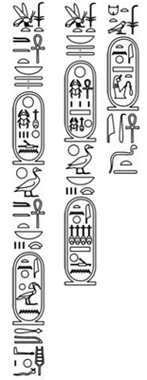Meritaten facts for kids
Quick facts for kids Meritaten |
||||||
|---|---|---|---|---|---|---|
| Great Royal Wife, King's Daughter | ||||||
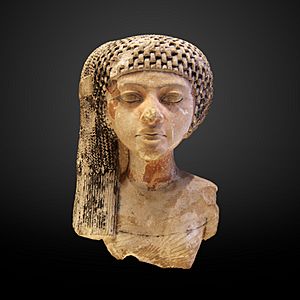
Bust of a daughter of Akhenaten and Nefertiti, perhaps the young Meritaten, in the Louvre, Paris
|
||||||
| Born | Possibly Thebes | |||||
| Spouse | Smenkhkare | |||||
| Issue | Meritaten Tasherit | |||||
| Egyptian name |
|
|||||
| Dynasty | 18th of Egypt | |||||
| Father | Akhenaten | |||||
| Mother | Nefertiti | |||||
| Religion | Ancient Egyptian religion and Atenism | |||||
Meritaten was an important ancient Egyptian princess and queen. Her name means "She who is beloved of Aten." Aten was the sun god her father, Pharaoh Akhenaten, worshipped. Meritaten held many important titles. She performed official duties for her father. Later, she became the Great Royal Wife to Pharaoh Smenkhkare. Smenkhkare might have been Akhenaten's brother or son. Some experts even think Meritaten ruled Egypt herself as pharaoh. She may have used the name Ankhkheperure Neferneferuaten.
Contents
Meritaten's Royal Family
Meritaten was the oldest of six daughters. Her parents were Pharaoh Akhenaten and his Great Royal Wife, Nefertiti. Her younger sisters were Meketaten, Ankhesenpaaten, Neferneferuaten Tasherit, Neferneferure, and Setepenre.
Meritaten's name, sometimes spelled Mayati, appears in old diplomatic letters. One letter from Abimilki of Tyre mentions her. This suggests her role in the royal court became more important later in Akhenaten's rule.
Meritaten married Pharaoh Smenkhare.
There was also a young princess named Meritaten Tasherit. She might have been the daughter of Meritaten and Smenkhare. Some ancient writings from Ashmunein suggest this. However, these writings are from Akhenaten's time. This means Akhenaten could have been the father of Meritaten Tasherit. The exact parentage of Meritaten Tasherit is still debated by historians.
Meritaten's Life Story
Early Years in Thebes
Meritaten was likely born in Thebes. This was early in her father's marriage to Nefertiti. She might have been born before Akhenaten became pharaoh. She is shown in official ceremonies by the fifth year of his rule.
The royal family first lived in Thebes. Their palace might have been part of the Temple Complex of Akhenaten at Karnak. Meritaten is shown with her mother Nefertiti in carvings. These carvings are in a temple called the Hut-Benben. Nefertiti was the main priestess there. Meritaten often appears behind her mother, shaking a sistrum (a musical instrument). Her younger sisters also appear, but less often.
Life as an Amarna Princess
In the fifth year of Akhenaten's reign, the royal family moved. They moved to a new capital city called Akhetaten (now known as Amarna). Meritaten's name appears on the boundary markers of this new city. During Akhenaten's rule, she was the most often shown and mentioned of his six daughters.
Her image appears in paintings in temples, tombs, and private chapels. She is shown in scenes of the pharaoh's family life. These family scenes were common during the Amarna period. She also appears in pictures of official ceremonies.
Two important places in Amarna are linked to Meritaten. These are the Northern Palace and the Maru-Aten. The Maru-Aten was a large area with pools, gardens, and pavilions. It had an artificial island with a painted floor showing nature scenes.
Meritaten's name replaced another royal lady's name in some places. This happened in the Northern Palace and the Maru-Aten. For a long time, people thought this meant Nefertiti had lost her royal position. But recently, experts found that the erased name was Kiya. Kiya was one of Akhenaten's other wives. This discovery showed that Nefertiti was not disgraced.
Becoming a Great Royal Wife
Meritaten eventually married Smenkhare. She became his Great Royal Wife. She is shown with him in the tomb of Meryre II. They are shown giving honors and gifts to Meryre. The exact timeline of the last years of the Amarna period is not fully clear. However, Smenkhare is thought to have ruled alongside Akhenaten.
Meritaten was Smenkhare's Great Royal Wife. Nefertiti remained Akhenaten's Great Royal Wife. Nefertiti still held her title in Akhenaten's 16th year. This means Smenkhare must have been a co-ruler at that time. Or he ruled with Meritaten sometime after Akhenaten's 16th year.
Meritaten's name is found on gold decorations from Tutankhamun's tomb. It is also on a wooden box for linen clothes. This box mentions two kings: Akhenaten and Ankhkheperure-mr-waenre, Neferneferuaten-mr-waenre. It also mentions the Great Royal Wife Meritaten.
Some scholars believe that Ankhkheperure Smenkhkare ruled with Meritaten. But Smenkhkare died the year after Akhenaten. One theory suggests Meritaten then became pharaoh herself. She might have ruled as king with the name Neferneferuaten. This pharaoh is said to have ruled for two years and one month. She is placed just before Tutankhamun in ancient records. Tutankhamun was Meritaten's half-brother.
Archaeologist Alain Zivie believes Meritaten also became a foster mother to Tutankhamun. She might be the person called Maia in some old records. Zivie noted that Thutmose, a famous sculptor, created a bust of Maïa. Thutmose was also the creator of the famous bust of Nefertiti.
Meritaten's Burial Plans
Ancient texts say Meritaten was supposed to be buried at Akhet-Aten. This is modern Amarna.
Let a tomb be made for me in the eastern mountain of Akhetaten. Let my burial be made in it, in the millions of jubilees which the Aten, my father, has decreed for me. Let the burial of the Great King's Wife, Nefertiti, be made in it, in the millions of years which the Aten, my father, decreed for her. Let the burial of the King's Daughter, Meritaten, [be made] in it, in these millions of years.
The royal tomb in Amarna was used for other family members. It was likely closed after Akhenaten's death. After that, Meritaten's burial might have been planned for one of the other royal tombs in Amarna.
See also
 In Spanish: Meritatón para niños
In Spanish: Meritatón para niños


